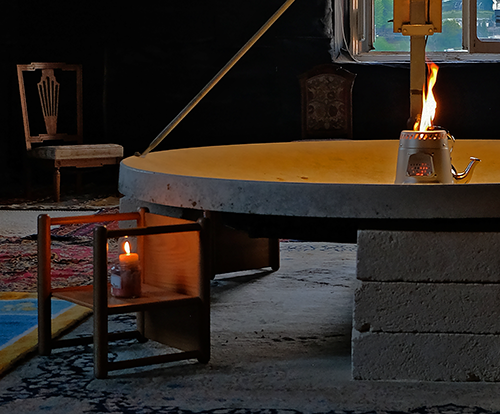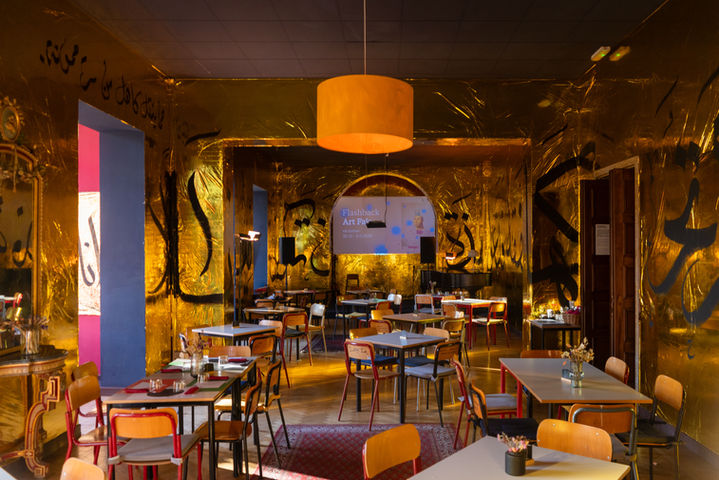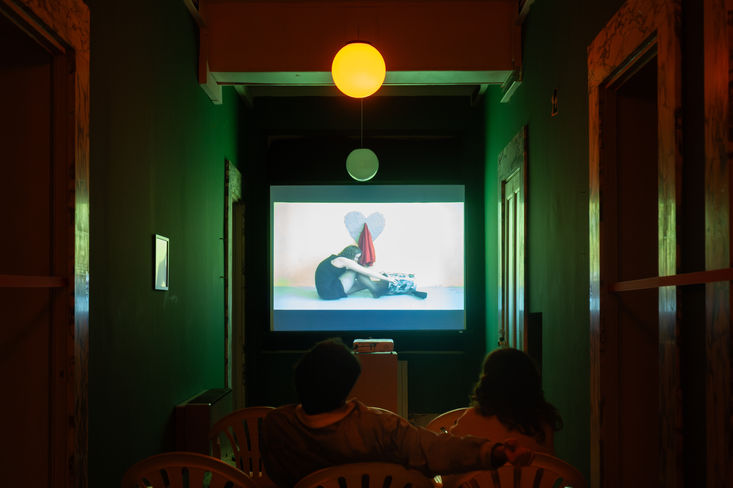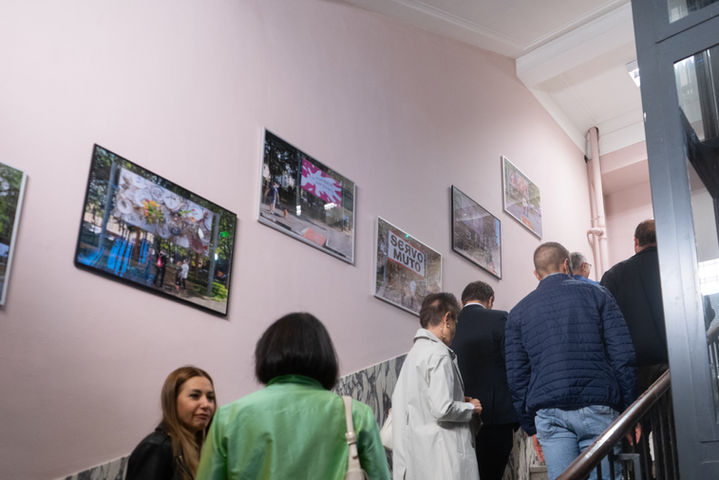Exhibitions
Permanent exhibitions
A better life.
Fragments of stories from the Institute for Children
of the Province of Turin
curated by Alessandro Bulgini
in collaboration with Città Metropolitana di Torino
The project presented at Flashback Habitat in Corso Giovanni Lanza 75 in Turin, whose title is A Better Life. Fragments of Stories from the Institute for Children of the Province of Turin is not to be considered an exhibition but rather an artwork and an act of love. A. Bulgini
The project aims to give voice to that multitude of worlds that have intertwined in the halls of the structure, a former orphanage in Turin, through glimpses of the stories of some of the protagonists who, firsthand, have experienced that place like the children, now adults, the nannies, the employees. The exhibition, curated by the artist and director of Flashback Habitat Alessandro Bulgini, aims to be a collective work, a choral work where history, emotions, art and life intertwine. An exhibition that tells intimate and personal stories, but incredibly universal because they are linked to concepts that touch us closely such as birth, family, identity, through original fragments, collected thanks to the collaboration of those who were there at the time, documents recovered in the historical archives of the Province of Turin and direct testimonies. The exhibition aims to be a complex, human, social and above all artistic fresco, which enhances everyone's lives by making them works of art, in the spirit and poetics of Flashback Habitat.
The exhibition is spread over the rooms on the third floor of Pavilion B in Corso Lanza. Each room wants to be a microworld where you can immerse yourself and enter the stories told. Personal and universal narratives at the same time, collective works that speak of life. Each room consists of audio-video portraits of the "natives" who answer the question "Can you tell me?" and they do it in profile: a position that suggests turning outside, elsewhere or perhaps towards another self. The talking portraits are accompanied by components dating back to a photographic exhibition on site set up when the orphanage closed. Finally, each room is enriched with a map-story with stratifications of meanings thanks to photographs and documents from public and private archives.
The IPI, inaugurated in 1958 by President Gronchi, every year hosted about three hundred boys and girls awaiting adoption, often born in corso Lanza 75, and then given up for adoption, generally before the age of three. Today many of those children, who have become adults, frequent the place and the activities of Flashback Habitat, recognizing their origins, their first home in Corso Lanza, enriching the new life of the place itself with stories and emotions.

mater
2023, Artist's Light, Constellation
by Alessandro Bulgini
Shaped sign with flat letters in painted aluminum, flex led lighting - 10mx2.78m
Roof of Pavilion C
Within the project: Luci d'Artista, Costellazioni, in 2023 Alessandro Bulgini's work mater arrived at the Flashback Habitat headquarters. Installed on the roof of Palazzina C and visible from Corso Vittorio Emanuele II to Porta Nuova station, the work is dedicated to those who were born more than forty years ago in the current headquarters of Flashback Habitat, the former orphanage of the Province of Turin active until the 1980s.
The light stands out on the roof of the oldest and highest villa of the former Institute, becoming a beacon in the darkness.
“Usually works are gifts, this one is even more so”
The story of this work begins when Alessandro Bulgini (artist and current artistic director of Flashback Habitat) entered the former Institute for Children of the Province of Turin in Corso Giovanni Lanza 75, a space entrusted to the Flashback Association, in particular when he learned of its history. A story that began in 1953 when the Province decided to open the Institute to meet the needs caused by large-scale immigration and the large number of women forced to leave their newborns in foster care. This space welcomed them for thirty years and then, to overcome this system, the space was closed. Having learned of this story, the artist decided to take action to recognize a place of welcome for those who were born here more than forty years ago, giving them a space where they could meet again. From the first contacts he took on the role of guide inside the four buildings, taking them to every interstice of the complex and making them retrace memories and suggestions that were so dear to them.
“Retracing the spaces, some of them touch the walls in search of the pictorial stratification that saw them present at their birth. This is why, with the passage of time, the idea that the mother was present in this place through absence took shape in me. The walls become epidermis. It is as if the mother had left, in the short time she was here, her own imprint. For this simple but profound reason I thought of giving them a clear indication that was materially visible, a work that would bring light to a desire”.
The words of Alessandro Bulgini.

Vivarium [der. from the Latin Vivo]
is the permanent exhibition that inhabits the external space of Flashback Habitat. The idea of also populating the powerful green area of 9000 square meters and transforming it into a real art park in metamorphosis and constant becoming was born in 2022, as soon as we entered what has become Habitat for Contemporary Cultures. The works of art are inserted into the space, to stay and "put down roots", giving life to a harmonious fusion where everything that is uniform comes from the dialogue between the artist and the habitat. In the natural environment composed of history and people, Flashback adopts the works that the artists leave in trust to the ecosystem.
Walking through the park of Flashback Habitat one encounters Chairs in Space (1995) by Fabio Cascardi, an installation in steel and anti-rumble paint inaugurated in April 2023 and recently moved to the highest point in front of Pavilion B. Also from 2023 is Mushroom Forest by Michel Vecchi, who, using wood and logs salvaged from the park, creates colourful mushrooms of surprise, magic and curiosity. On the occasion of Flashback Art Fair 2024, the work is enriched with sounds that the artist himself recorded in the park, transforming them into a natural soundtrack. Michel Vecchi is an artist from Valle d'Aosta who lives and works in Ibiza.
Also from 2023 is the work Tout se tient by Luisa Raffaelli, also created by enlivening elements already present in the park. The artist transforms a structure that acts as a sling and the protection, also metaphorical, is composed of innocent pipes that give a sense of care, protection and safety, coloured gold to emphasise the protective function. Finally, Carl Von Pfeil has created four site-specific anthropomorphic sculptures in 2024, with materials found in the park, that dialogue with the natural ecosystem: Woman with Open Arms, Wandering Man, Chick with Goldilocks and
One-Eyed Painter.
After the large light installation mater, on the occasion of Flashback Art Fair 2024, Flashback Habitat's artistic director Alessandro Bulgini also enriches Vivarium with Light of the Apocalypse, a work that weaves personal memory, history and universal reflection through powerful symbolism and intense colours. A large beech tree - dead, but present not only as memory - painted bright red and made extraordinary by lights and luminous spheres is the symbol of a historical and present time in which we are constantly immersed. Each of Bulgini's creations draws from the pre-existing to revive in the present and, as in a flashback, brings past time and present time into dialogue. Red, omnipresent in his works from 1993 to 2000, becomes a colour of universal connection: a symbol of passion, war, life and blood, it brings together the deepest meanings of the human condition. The centuries-old tree, dead due to climatic imbalances, becomes the beating heart of the work: the artist decides not to ‘cut it down’, but to transform it into a sculpture, evoking a crown or the effect of an object falling into water and generating splashes. Dyed red, it becomes a symbol of an alien or nuclear explosion, with orange luminous spheres crystallising the contradictions of our time. Night adds a mystical dimension to the work: the light it emanates evokes the eclipse, an event that in popular belief was a source of terror and magic. On display at the entrance to Pavilion B, six photographs of Bulgini's daily life taken at different times complete the work: filtered in the same red as the sculpture, they amplify its sense of apocalypse.
Light of the Apocalypse embodies the tension between the sacred and the profane, between rebirth and destruction, inviting the viewer to reflect on the search for Equilibrium through contrasting worlds.
Temporary exhibitions
Neverland Gaza
Curated by Alessandro Bulgini
every Thursday with mandatory reservation
Pav. C - Zone closed to visitors, second floor
'Neverland Gaza' has been created as a space of proximity and resonance.
An intimate installation built from everyday objects donated by people - carpets, chairs, lamps, a camping stove - that become instruments of relationship. The work stages an imaginary ritual inspired by the gesture of sharing tea in the ruins of Gaza during Ramadan. In this suspended and disarmed context, art becomes habitable, real, deeply our space.
"A work of art does not describe, it does not comment, it does not communicate" - writes Christian Caliandro in the text supporting the project - "it does not deal with a subject: it lives it, it goes through it, it experiences it. And this something is no longer a subject. It is reality".
The installation can be visited
every Thursday at 8 p.m.
Free entrance with mandatory reservation
(maximum of 30 people)
tel: +39 393 64 55 301
mail: info@flashback.to.it
Compassione
by Alexander Mostafa Fazari
curated by Alessandro Bulgini
Pav. C - Il Circolino
Starting from 23 October, a new artwork inhabits the spaces of Il Circolino. At the center of the installation lies a symbolic and humble material: the thermal emergency blanket. A fragile veil that evokes suffering, survival, and the shared vulnerability of human beings. It carries with it the voices of those who resist and recalls the subtle line between protection and exposure.
On this material, the hand of Egyptian artist Alexander Mostafa Fazari traces Arabic calligraphy words of Gibran, Rumi, and Ibn Arabi. Their poetry brings the timeless language of love, compassion and unity. The flowing letters recall the Sufi spiritual tradition, where writing itself becomes prayer and movement of the soul. Together, material and word create spaces of empathy. An invitation to feel the suffering of others as one’s own, to return to compassion as an origin, as an instrument of connection in these uncertain times.
This is not only an artwork. It is an invitation: to gather, to listen, to reflect, to share a common sense of humanity. In such an uncertain historical moment like this, to re-discover compassion is a revolutionary act.
BIO
Egyptian artist Alexander Fazari is best known for works in Calligraphy that cleverly combine a variety of media in an ongoing investigation into the dynamics that govern society, trying to get the most out of the cultural and artistic side of the city. A creative spirit, an enterprising mindset, and a wanderlust attitude are three of the ingredients that make him not only a passionate artist but also a Person who takes inspiration from everything that surrounds him to integrate Calligraphy and Typography in different languages in an Artistic Frame.
Alexander is also well known for his alternative photography which combines different techniques of darkroom and digital photography with body painting and calligraphy.
Alexander’s work has been taken up by various private collections. He currently lives and works in Turin, Italy.
Butterfly
Videoart exhibition
curated by Rebecca Russo
in collaboration with Videoinsight® Foundation
from 25/09/2025 through 29/03/2026
Pav. B - first floor
The butterfly is one of the most powerful and widely recognised symbols of transformation, rebirth and inner beauty. Its life cycle — from egg to larva, then to chrysalis and finally to a winged creature — represents profound change and growth. The butterfly is also a symbol of the soul, representing the passage between worlds, life and death, and darkness and light. Representing freedom and the brightness of being, the butterfly also symbolises fragility and impermanence, as its existence is brief yet intense, much like certain precious moments in life. The butterfly encourages us to let go of the past, embrace change and find the courage to evolve. It reminds us that even something seemingly motionless or dark, such as a chrysalis, can hold the potential for something wonderful.
Although human wounds may be painful, they can become wings that enable us to fly towards emancipation and awareness. They act as gateways through which light enters. Every pain we experience, every fall we take and every loss we endure leaves a mark. These are not just sufferings, but memories, experiences and truths. Losses and limitations create cracks through which the potential for transformation is revealed. Fragility can lead to authenticity, strength and luminosity. When failure is approached with awareness, it can lead to compassion, depth and art. Scars tell a story; they are not defects, but a truer form of beauty. Vulnerabilities can become resources, such as sensitivity, the ability to understand others and a desire for authenticity. The butterfly is poetry in motion — a silent messenger of hope, transformation and new life.
Selected artworks from the Videoinsight® Collection:
Janet Biggs, Can't find my way home, 2015, 09’ 45’’
Maurizio Camerani, Sub, 1994, 06’ 06’’
Emilia Faro, The Prince's metamorphosis, 2010, 03’ 29’’
Michael Fliri, Getting too old to die young, 2008, 00’ 47’’
Kate Gilmore, My love is an anchor, 2004, 07’ 06’’
Goldiechiari, 1969, 2010, 04’ 23’’
Vlatka Horvat, Restless, 2010, 08’ 18’’
Polina Kanis, Eggs, 2010, 17’ 28’’
Ali Kazma, Dance Company, 2009, 10’ 17’’
Edson Luli, What is man, 2014, 06’ 55’’
Marcos Lutyens, The subjective self: twinnapse, 2013, 01’ 40’’
Ursula Mayer, The crystal gaze, 2007, 14’ 39’’
Marcello Maloberti, Blitz, 2012, 07’58’’
Masbedo, Glimà, 2008, 18’ 26’’
Hans Op De Beeck, Parade, 2012, 11’ 17’’
Fabrizio Passarella, Il Giardino Rabescato, 2003 - 2016, 15’ 48’’
Fabrizio Passarella, Dreams, 2022 - 2025, 17’ 30’’
Cheryl Pope, Stacks, 2010, 10’ 05’’
Sissi, Daniele ha perso il treno, 1999, 01’ 30’’
Michele Tombolini, Indelible marks, 2016, 07’ 13’’
Ulla Von Brandenburg, Singspiel, 2009, 06’ 39’’.
Gaza Opera Viva / Opera Viva Barriera di Milano, il Manifesto - Stargate to Gaza
By Alessandro Bulgini
Curated by Christian Caliandro
Pav. B - Stairs
The artistic project Opera Viva by Alessandro Bulgini has always had as its central aim the illumination of those removed, marginal, submerged zones of existence and everyday reality – and to achieve this through pure presence, through the artist’s discreet action.
In this sense, the red “uniform” becomes a signal, an indicator: it stands for a possible connection, a tenuous yet essential link. The author thus becomes – as Giulio Paolini once wrote – the bearer of the work: and the work itself is the context, or rather, the relationship with the context. Observing Bulgini’s body and the sign of this red T-shirt as it positions itself in the centres of cities (Milan, Rome, Turin) and among the stands of contemporary art fairs (Art Basel, miart) immediately establishes a connection, a relationship that is at once a detachment, a distance: the distance that separates a touristic, creative and economic world that seems intent on carrying on with its business as if nothing had happened – determined, at all costs, to look the other way – and the trace, the memory, the symptom of something that has gone wrong, terribly wrong. Something out of place, and destined to remain so. Something which, like all that is repressed – and like the sailing boat with the flag atop its mast rising high on the wall of the first room – will return again and again and again…
Opera Viva Barriera di Milano
The Billboard
Pav. B - Stairs
A collection of images from the editions of the local project ‘Opera Viva Barriera di Milano - Il Manifesto’ curated by Alessandro Bulgini.


























